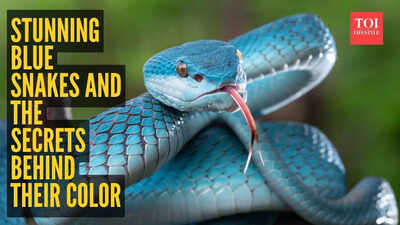ARTICLE AD BOX

Snakes are already fascinating creatures, but blue snakes are truly something special. Their striking blue colours make them stand out in forests, rivers, and even oceans, catching the eye of anyone who spots them.
Some blue snakes are small and harmless, while others are venomous and should be admired from a safe distance. They can be found across different continents, from tropical forests to coastal waters, showing just how diverse and unique wildlife can be. Beyond their beauty, these snakes play important roles in their ecosystems, helping control pests and maintain balance in nature. Here’s a closer look at some of the world’s most remarkable blue snakes and what makes them so extraordinary.Blue-Striped Garter SnakeThe Blue-Striped Garter Snake is a small snake found in Florida. Its body is thin and can be gray, brown, black, or greenish, with bright blue or yellow stripes along its back and sides. They usually grow about 18–26 inches long. They eat small animals like salamanders, fish, worms, snails, slugs, leeches, and tiny mammals, often swallowing their prey whole, even if it’s still alive.

Blue Phase Common Tree SnakeIn Australia, Common Tree Snakes are usually yellow, green, brown, or black, but sometimes a rare blue one appears.
The blue can be bright or dark. These snakes can grow up to six and a half feet long. They are non-venomous and mostly eat skinks and frogs, so they are harmless to people.Bluestripe Ribbon SnakeThe Bluestripe Ribbon Snake lives along Florida’s Gulf Coast. It has a long, thin body that can be black, brown, or dark blue, with light blue stripes on the sides. It lives partly in water and eats frogs, salamanders, worms, and small fish. These snakes are non-venomous and very fast, often slipping into water to escape danger.Malabar Pit ViperThe Malabar Pit Viper is found in India’s Western Ghats. Its colour can be brown, green, yellow, or light blue, often with patterns on its back. It moves slowly but can strike quickly if threatened. Its venom causes pain and swelling but is usually not deadly to humans. They are most commonly seen during the monsoon season.

Vietnamese Blue Beauty SnakeThe Vietnamese Blue Beauty Snake is a type of Beauty Rat Snake found in Vietnam, Cambodia, and Thailand.
Its long, slender body can be blue or silver, sometimes with dark patterns along its length. Some have solid-coloured tails with thin stripes. They grow 5–11 feet long. They are non-venomous but can bite if threatened. The bite hurts, but is not dangerous.White-Lipped Island Pit ViperThe White-Lipped Island Pit Viper lives on the Lesser Sunda Islands and Eastern Java. Its colours can be green, yellow, or blue-green. Blue ones are rare and mostly seen on Komodo Island.
These snakes live in trees and are venomous. They can be aggressive, but their venom is usually not deadly to humans.Eastern Indigo SnakeThe Eastern Indigo Snake is one of the largest non-venomous snakes in the southwestern United States. Its body is dark blue-black with shiny scales, and some may have red, orange, or tan on the head and throat. They usually grow 5–7 feet long, though some can reach over 9 feet. These snakes are calm and gentle.
They are a threatened species, and efforts are being made to protect them.

Blue Malayan Coral SnakeThe Blue Malayan Coral Snake has a thin, dark blue or blue-black body with bright red on the head, belly, and tail. A light stripe runs along each side. It lives in Southeast Asia and grows 55–70 inches long. This snake is highly venomous, and its bite can cause paralysis.Blue-Lipped Sea KraitThe Blue-Lipped Sea Krait lives in the western Pacific and Indian Oceans. It has a smooth blue body with black bands and grows 36–42 inches long.
This sea snake is venomous but not aggressive. It lives both in water and on land, hunting near coral reefs.Blue RacerThe Blue Racer is found in the U.S. and parts of Canada. Its sleek, powder-blue body shines in the sunlight. Non-venomous and shy, it moves very quickly to escape danger. Its speed and striking colour make it one of the most beautiful snakes in North America.Disclaimer: The details in this article are based on online sources and ecological studies. Information may differ depending on species and region.Images: Canva (for representative purposes only)

 1 day ago
8
1 day ago
8









 English (US) ·
English (US) ·